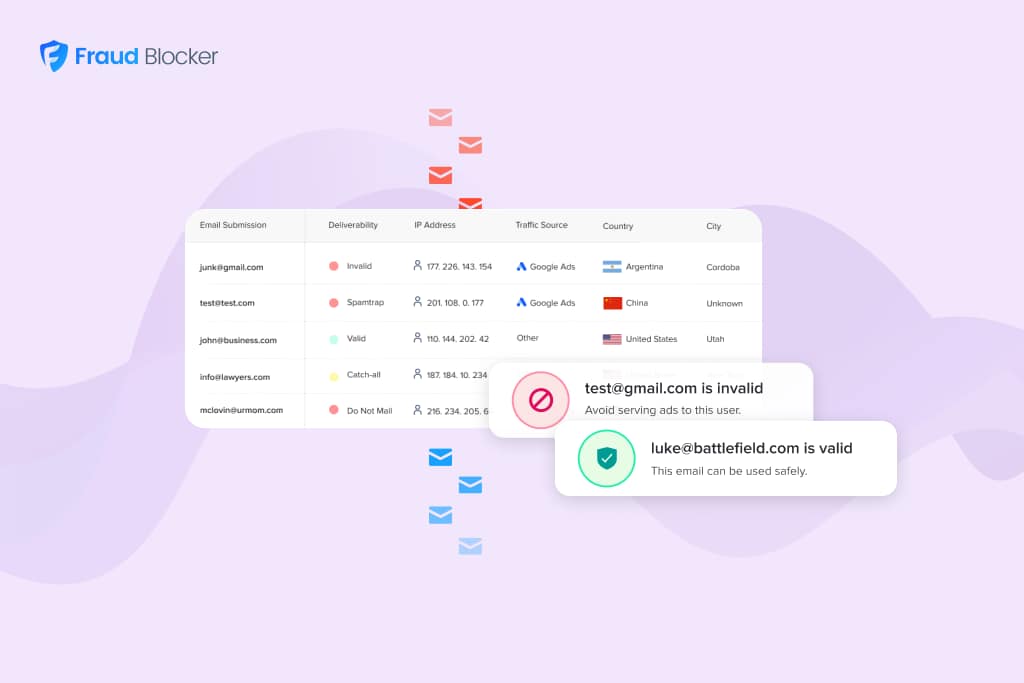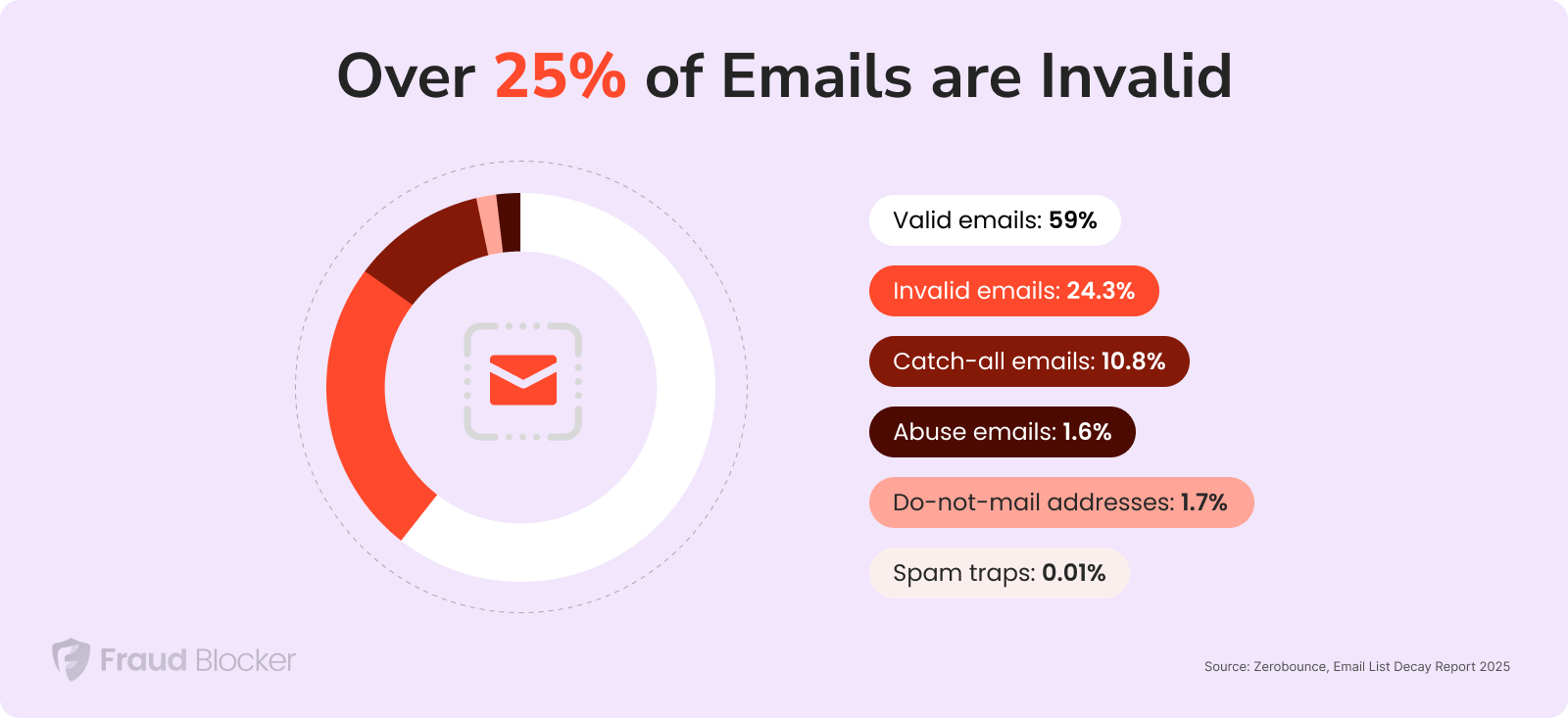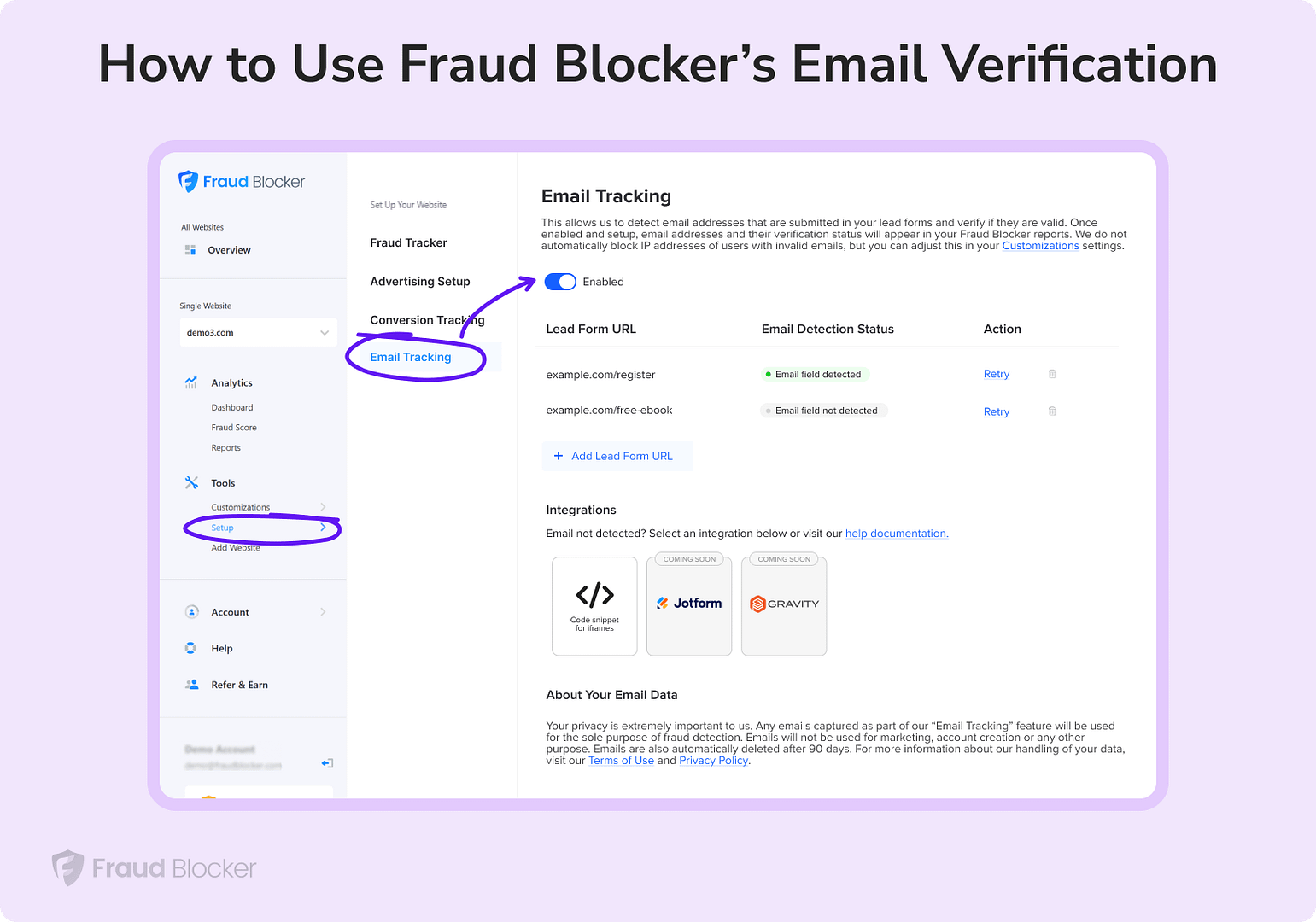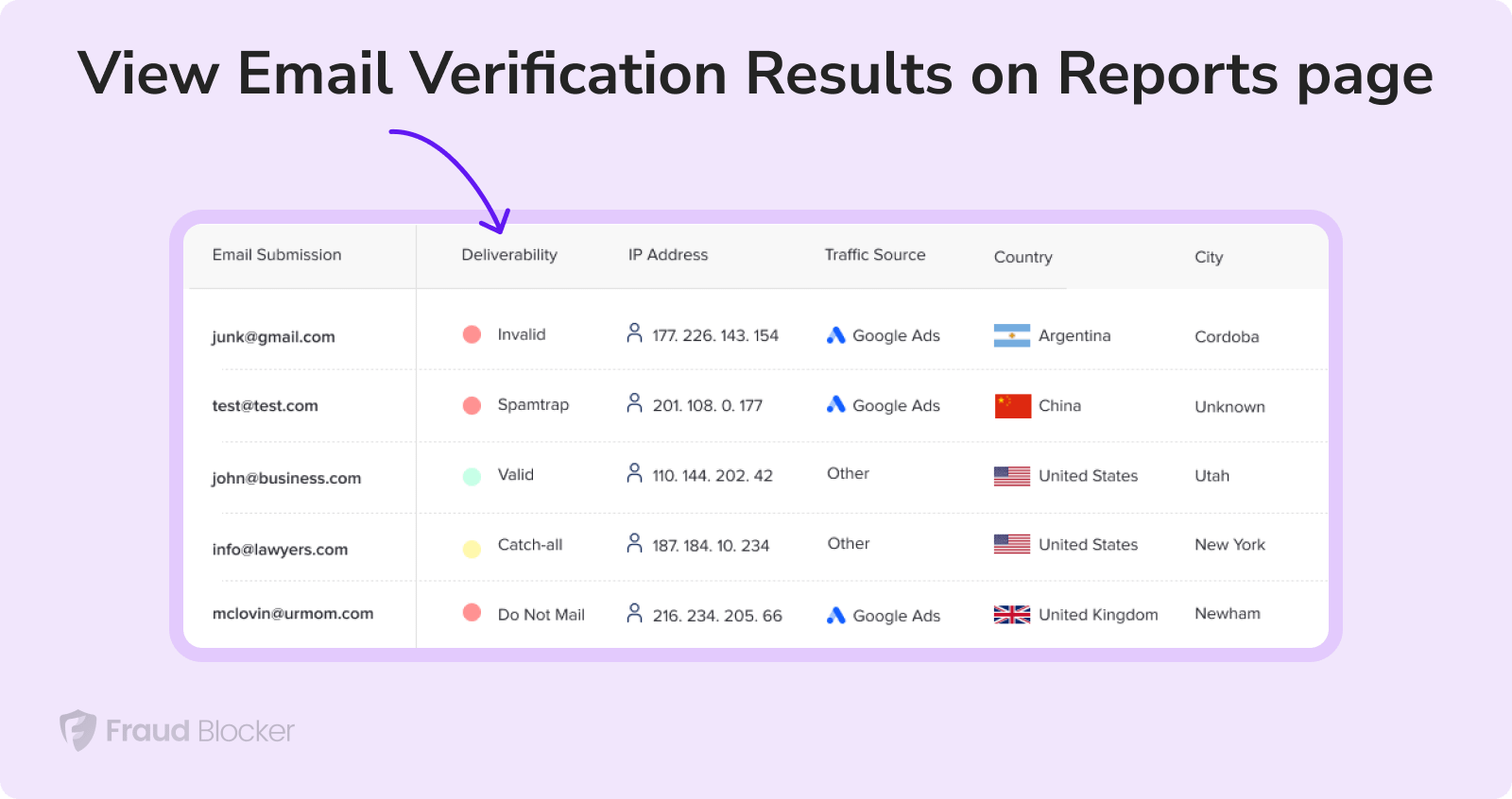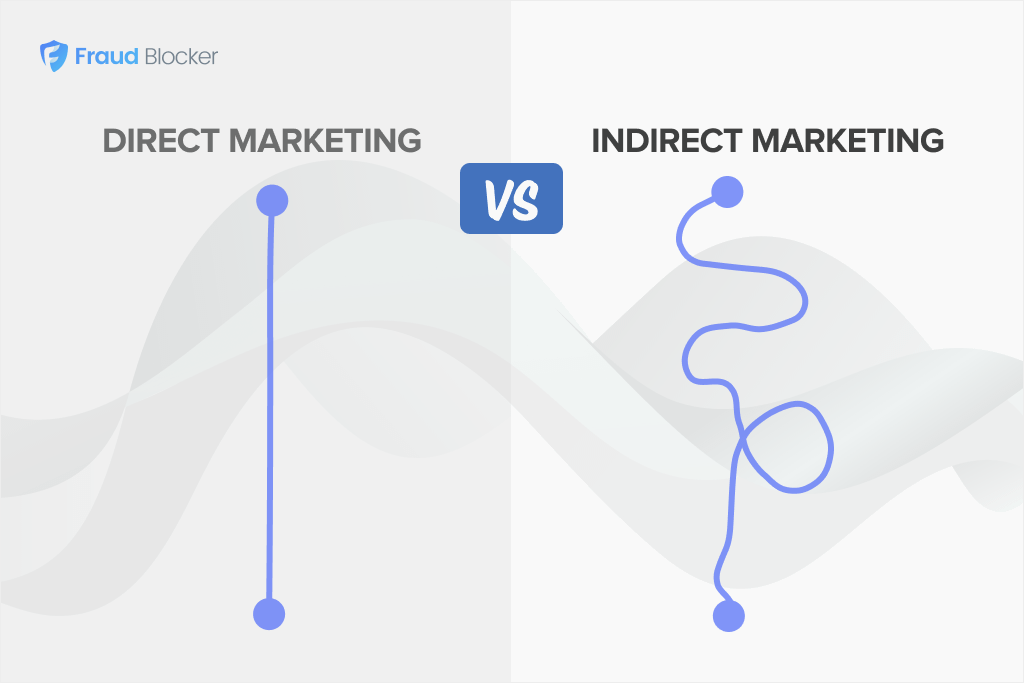
Email Verification Explained: Your Weapon Against Fake Leads
- November 16, 2025
Fake leads cost marketers twice: once in wasted ad spend and again in lost sales time. Bot submissions, fake signups, and invalid emails can distort your performance data, pushing algorithms to double down on low-quality traffic sources. The outcome? You spend more, but close less.
Facebook recently removed 700 million fake accounts in Q2 of 2025. If a platform that size struggles to filter out fake data, imagine what slips through your lead forms every day.
That’s why businesses need email verification. It stops fake leads at the source, verifying addresses before they hit your database. And now, Fraud Blocker includes a built-in email verification tool to help you catch fake submissions and block the source from further campaign interactions, protecting your budget.
In this blog, we’ll show exactly how fake leads derail your campaigns, and how Fraud Blocker’s new email verification tool helps stop them instantly.
What is email verification?
Email verification is the process of checking whether an email address is real, safe, and ready to receive messages before you store or use it.
During email verification, tools run a quick series of checks:
- Syntax and domain check: Confirms the email is properly formatted and linked to a valid domain.
- Disposable email detection: Flags temporary or throwaway emails from services like Mailinator or Guerrilla Mail.
- Mailbox verification: Uses a brief SMTP connection to confirm the mailbox exists and can receive emails, helping reduce bounces and fake entries.
What’s the difference between email validation and email verification?
Email validation checks that an email address is formatted correctly and could exist. Email verification goes a step further and checks whether the specific address is active and able to receive messages.
Email validation answers, “does this look like a real email address?” and email verification answers, “does this email address really work?”
The impact of fake leads on your marketing performance
When bots or bad actors fill out your forms using bad emails or fake information, they trigger conversions that look real to ad platforms like Google or Meta. Those platforms then optimize your campaigns around these fake engagements, sending even more traffic from the same bad sources. The result is a feedback loop that inflates your costs and lowers real conversion rates.
And it’s not just bots. Some fake leads come from lead generation fraud, affiliate fraud, or even real users who want free value without giving real details.
The longer fake leads sit in your system, the more it affects your data. That’s why stopping fake leads with email verification is a critical step.
Here’s how fake leads affect your campaign performance:
- Wasted ad spend: Ad platforms interpret fake conversions as success signals, pushing more budget toward bad traffic sources.
- Distorted analytics: Inflated conversion numbers make it harder to measure real ROI or optimize campaigns.
- Polluted CRM data: Sales teams chase junk contacts, wasting time and damaging productivity.
- Hurt deliverability: Repeatedly emailing invalid addresses lowers your sender reputation and increases bounce rates.
- Mislead algorithms: Automated bidding and targeting tools learn from fake interactions, lowering future campaign performance.
- Damaged attribution: With bad data, it’s nearly impossible to tell which channels or campaigns truly drive growth.
According to Zerobounce, 25% of emails are invalid. There are also spam traps, do-not-mail addresses, and abusive emails. In fact, only 59% of all email leads are valid. This is why, for marketers, email verification is a critical line of defense against fake signups and bad data.
Read More: How to prevent bots from submitting forms on your website.
Email verification stops fake leads at the source
Email verification acts like a filter between your ad campaigns and your CRM. It confirms if the emails submitted in your forms are real, active, and not linked to a disposable domain. If the email fails any of those checks, the submission is automatically rejected or flagged.
This single step cuts off a common source of fake leads.
Best practices for using email verification in your campaigns
Email verification works best when it’s built into your daily marketing workflow, not treated as a one-off cleanup task. Here are a few ways to get the most out of it:
Verify emails at the point of capture
Always verify emails as soon as users submit a form. Swift verification keeps fake leads out of your CRM and prevents wasted ad spend.
Clean existing lists regularly
Even the best-managed databases can collect bad addresses over time. Run batch verifications every few months to remove invalid or inactive contacts before they damage your deliverability.
Integrate with your CRM and automation tools
Connect verification with platforms like HubSpot, Salesforce, or Zapier so clean data flows directly into your campaigns and automations.
Review your reports
Monitor your verification tool dashboard to spot patterns in bad submissions like recurring disposable domains or bot-heavy traffic sources. These insights can guide smarter targeting and exclusions.
Fraud Blocker’s email verification helps improve your ad performance
Fraud Blocker’s email verification feature takes fake lead prevention one step further. It automatically checks every email submitted through your website forms, blocking users with invalid or risky addresses and excluding their IPs from all of your ad campaigns.
Here’s how it works
- Built into your existing setup: The same Fraud Tracker script you already use for click fraud protection detects email fields on your forms.
- Instant verification: Every email is analyzed in real time using a third-party email verification service. It checks syntax, DNS, and SMTP status to confirm the mailbox actually exists.
- Advanced risk detection: The system identifies disposable emails, spam traps, catch-alls, aliases, and other high-risk types that can damage deliverability or skew analytics.
- Custom blocking options: You can decide which types of email submissions (alternate, invalid, temporary emails) should trigger a block and which ones are ignored.
- Unified reporting: All email deliverability statuses will appear in your Fraud Blocker dashboard alongside your click and IP data, giving you a single view of traffic quality.
Setting up Fraud Blocker’s email verification tool
Setting up email verification in Fraud Blocker takes just a few minutes. If you’re already using the Fraud Tracker script for click fraud protection, you don’t need to install anything new as the same script now powers email verification automatically.
Here’s how to get started
- Go to Setup > Email Verification in your Fraud Blocker dashboard.
- Click Enable to activate the feature.
- Add the website URLs that include your lead forms with email fields.
Once added, Fraud Blocker will start verifying every new email submission in real time. - Go to customizations to choose which types of emails to block. For example, you can choose to block all invalid or temporary email addresses.
You can view the results in your Reports tab. Each submission includes a deliverability status, such as valid, invalid, disposable, spam trap, or unknown. Results typically appear within an hour of the submission.
The email verification feature is available for all PRO plan customers.
You can try Fraud Blocker free for 7 days and see how many fake leads you can block this week.

ABOUT THE AUTHOR
Matthew Iyiola
Matthew is the resident content marketing expert at Fraud Blocker with several years of experience writing about ad fraud. When he’s not producing killer content, you can find him working out or walking his dogs.
Matthew is the resident content marketing expert at Fraud Blocker with several years of experience writing about ad fraud.
More from Fraud Blocker


Browser Fingerprinting: Everything You Ever Wanted to Know, Start to Finish

